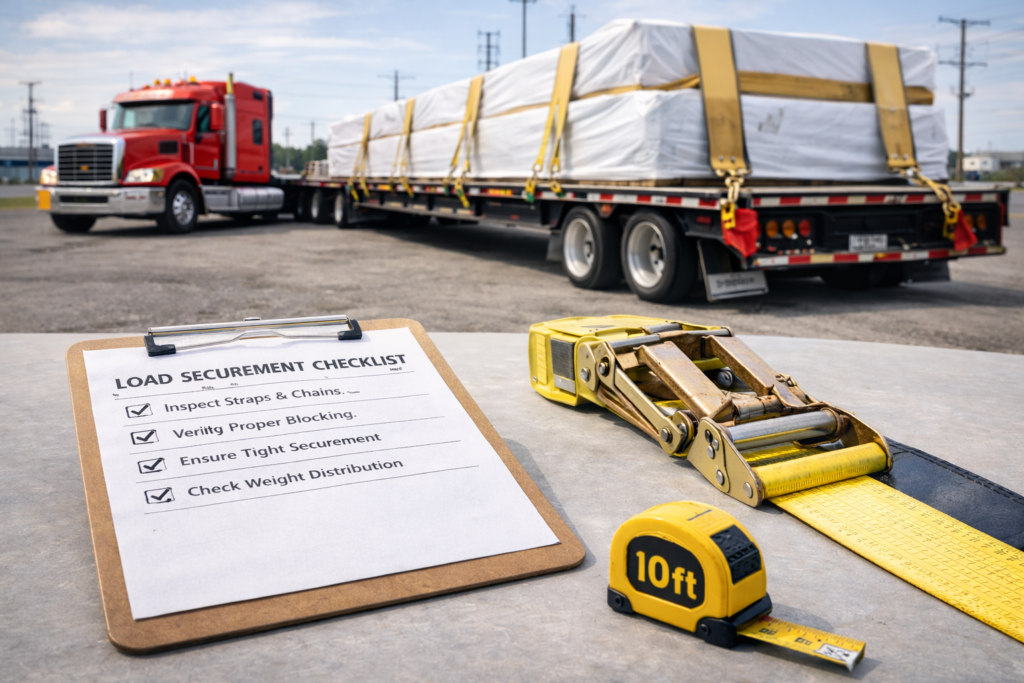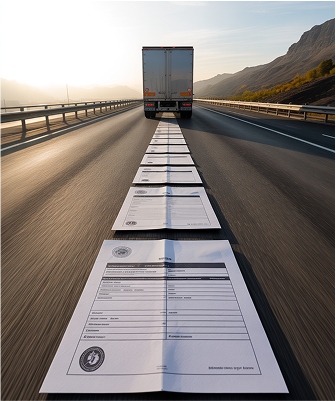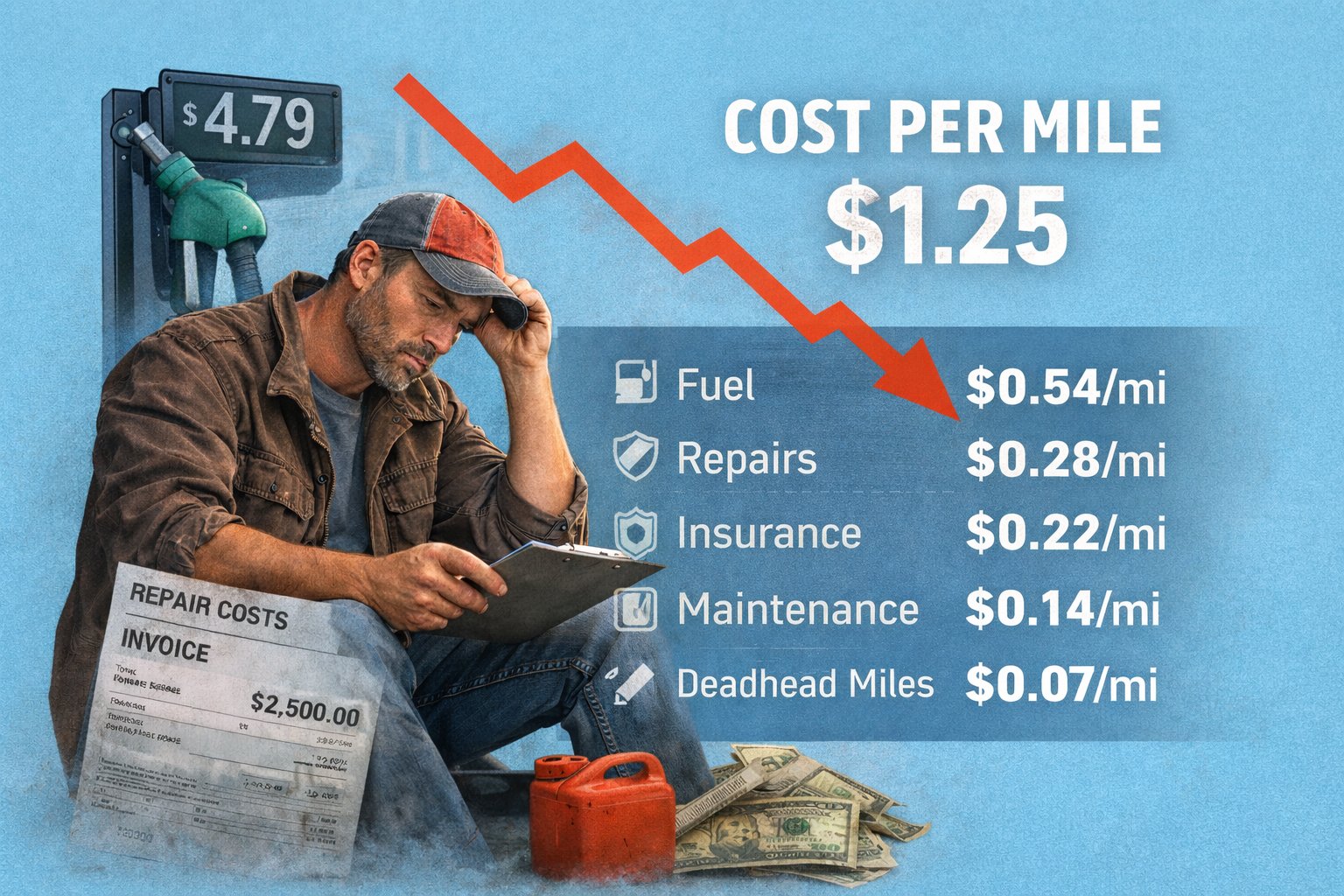Table of Content
- Why Flatbed Load Securement Matters
- Key Principles of Flatbed Load Securement
- Tools of the Trade: Tie-Downs, Binders, and Tarps
- Best Practices for Securing Loads on a Flatbed
- Common Load Types and Their Securement Tips
- Avoiding Common Mistakes
- Stay Ahead: Training and Compliance
- Drive Now — Leave the Permits to Us
- In a Wrap

In the fast-paced world of logistics and transportation, flatbed trucking plays a critical role in moving oversized, heavy, or oddly shaped cargo. However, transporting freight on a flatbed trailer comes with unique challenges—chief among them is ensuring the load remains secure from point A to point B. Improper flatbed load securement not only endangers the driver and other motorists but also violates strict DOT regulations, potentially resulting in costly fines and delays.
Whether you’re a seasoned trucker or just starting in the industry, understanding the best practices for securing loads is non-negotiable. In this guide, we’ll explore the essentials of flatbed load securement, from choosing the right tie-downs and binders to prevent load shifts and using tarps effectively.
Why Flatbed Load Securement Matters
Flatbed trailers differ from enclosed trailers in one crucial way: there are no walls or a roof to contain the cargo. This means that the responsibility for keeping the freight in place lies entirely in the securement methods used. An improperly secured load can shift, fall, or even cause rollover accidents, especially during sudden stops or sharp turns.
In addition to the safety risks, there are stringent Department of Transportation (DOT) regulations that govern how cargo must be secured on flatbeds. These regulations define the minimum number of tie-downs, the working load limits of securement devices, and specific rules based on cargo type and weight.
Key Principles of Flatbed Load Securement
1. Understand the working load limit (WLL)
The Working Load Limit is the maximum load a securement device (like a chain, strap, or ratchet) can safely handle. When securing a load, the combined WLL of all tie-downs used must equal at least half the weight of the cargo. This ensures that, even in an emergency braking scenario, the securement system can hold the freight in place.
Example: If you’re hauling a 10,000 lb piece of machinery, your securement devices must have a combined WLL of at least 5,000 lbs.
2. Know your DOT regulations
According to DOT regulations outlined by the FMCSA (Federal Motor Carrier Safety Administration), cargo securement is governed by specific standards:
- At least four tie-downs are required for loads over 10 feet in length.
- One tie-down must be placed every 10 feet or part thereof.
- If the cargo is shorter than 5 feet but weighs more than 1,100 lbs, it still requires at least two tie-downs.
Failure to comply can result in citations, out-of-service orders, and loss of cargo if the load shifts or detaches.
Tools of the Trade: Tie-Downs, Binders, and Tarps
Tie-downs
These are your first line of defense. Tie-downs include chains, webbing straps, and synthetic ropes, each suited for different types of cargo. Always inspect your tie-downs for wear, fraying, or damage before use. Never use a device with compromised integrity, no matter how minor it seems.
- Ratchet straps are ideal for securing lighter freight or irregular loads.
- Steel chains offer unmatched strength for heavy-duty applications.
Binders
Binders are used in conjunction with chains to apply tension. There are two main types:
- Ratchet binders: Offer controlled tensioning and are safer to release under load.
- Lever binders: Simpler but require more manual effort and can pose a safety risk if released incorrectly.
When using binders, ensure that the tension is evenly distributed across the load to prevent uneven pressure and potential load shifts.
Tarps
Tarps protect cargo from weather elements like rain, snow, and sun exposure. But they also help maintain the structural integrity of the load during transport.
There are different types of tarps, such as:
- Lumber tarps: for protecting lumber or other building materials.
- Steel tarps: made for flat steel or machinery.
- Machinery tarps: for irregularly shaped equipment.
Tarps must be properly secured to prevent them from becoming hazards themselves. A flapping tarp can wear down due to wind and potentially come loose.
Best Practices for Securing Loads on a Flatbed
1. Pre-Trip inspection
Before every trip, conduct a thorough inspection of:
- All tie-downs and binders for signs of wear
- The load itself for proper placement and weight distribution
- Trailer deck conditions (clean and dry surface to prevent shifting)
2. Load placement
Proper placement of the load can significantly reduce the risk of load shifts. Keep the center of gravity as low and as centered as possible. Avoid overhanging cargo unless absolutely necessary — and if so, follow the overhang securement rules.
3. Use edge protection
Sharp edges on cargo can cut into straps and reduce their effectiveness. Use edge protectors to prevent damage to both the cargo and the securement devices.
4. Secure from all angles
A common mistake is only securing the load from the sides. Secure from multiple angles — front, back, and sides — especially for taller or uneven loads.
5. Recheck after the first 50 miles
One of the most crucial steps in flatbed load securement is the first check-in. After driving about 50 miles, pull over and re-tighten all tie-downs. Vibrations and road conditions can loosen even the best-secured load.
Common Load Types and Their Securement Tips
Machinery and equipment
Heavy-duty machinery requires chains and ratchet binders. Use at least four tie-downs, ensuring that each corner is anchored. Watch out for sharp edges that could damage your equipment.
Lumber and building materials
These are susceptible to load shifts due to their long and narrow shapes. Use lumber tarps and place multiple tie-downs along the entire length. Consider using friction mats under the load to increase stability.
Pipes and cylindrical cargo
Pipes can roll if not properly chocked. Use wedges or cradles in addition to straps and chains. Ensure that the contact points between the load and trailer are level.
Avoiding Common Mistakes
- Over-tightening: while tension is essential, over-tightening can damage both the load and your securement equipment.
- Ignoring weight distribution: uneven loads can lead to jackknifing or tipping.
- Assuming all cargo is the same: every load type has unique securement needs — always tailor your strategy.
Stay Ahead: Training and Compliance
Ongoing training is vital. The FMCSA offers free online resources, and many logistics companies conduct internal training on flatbed load securement best practices. Regular refresher courses ensure that drivers stay up-to-date with evolving DOT regulations and new equipment options.
Additionally, using load securement software or checklists can help drivers stay organized and compliant. Investing in mentorship programs or peer-to-peer learning opportunities can also strengthen a company’s safety culture. Veteran drivers have real-world experience with challenging loads, unexpected road conditions, and on-the-fly adjustments—insights that are invaluable for newer team members. Encouraging knowledge-sharing not only reinforces securement fundamentals but also fosters accountability and teamwork across your fleet.
In a Wrap
Safety in the logistics industry begins with proper flatbed load securement. While it might seem like a routine task, the consequences of neglecting best practices can be catastrophic. By using the right tie-downs, applying binders correctly, protecting your freight with tarps, and adhering to DOT regulations, you don’t just protect your cargo — you protect lives.
Whether you’re hauling steel beams across the country or delivering lumber to a local job site, securement should never be an afterthought. Make it a habit, make it a priority — and most importantly, make it safe.









